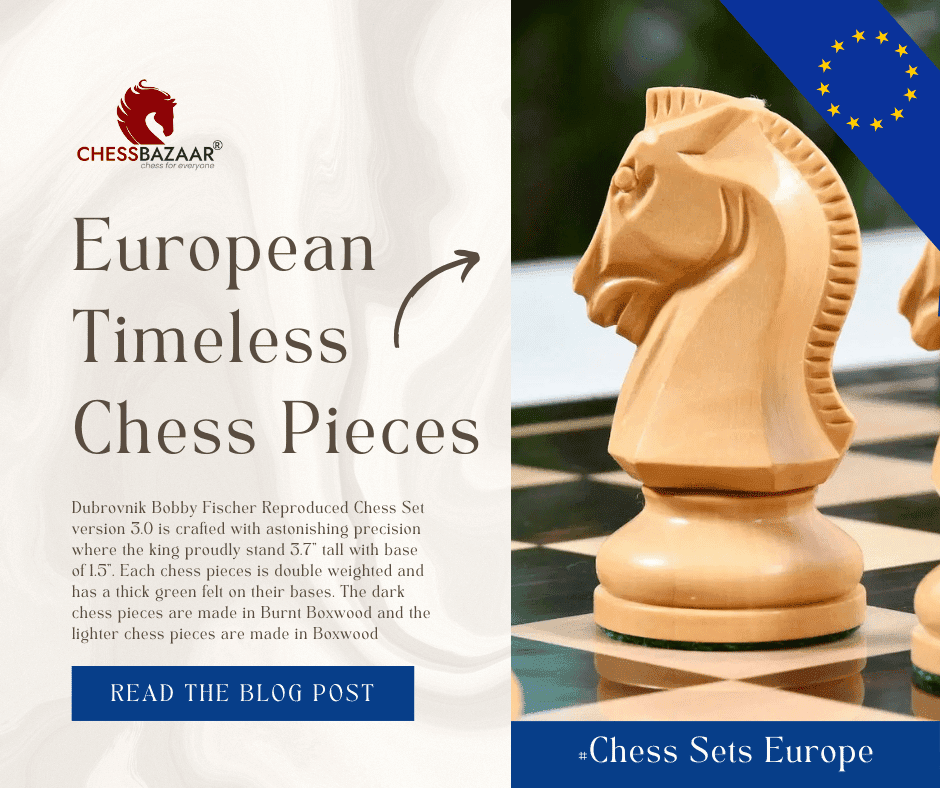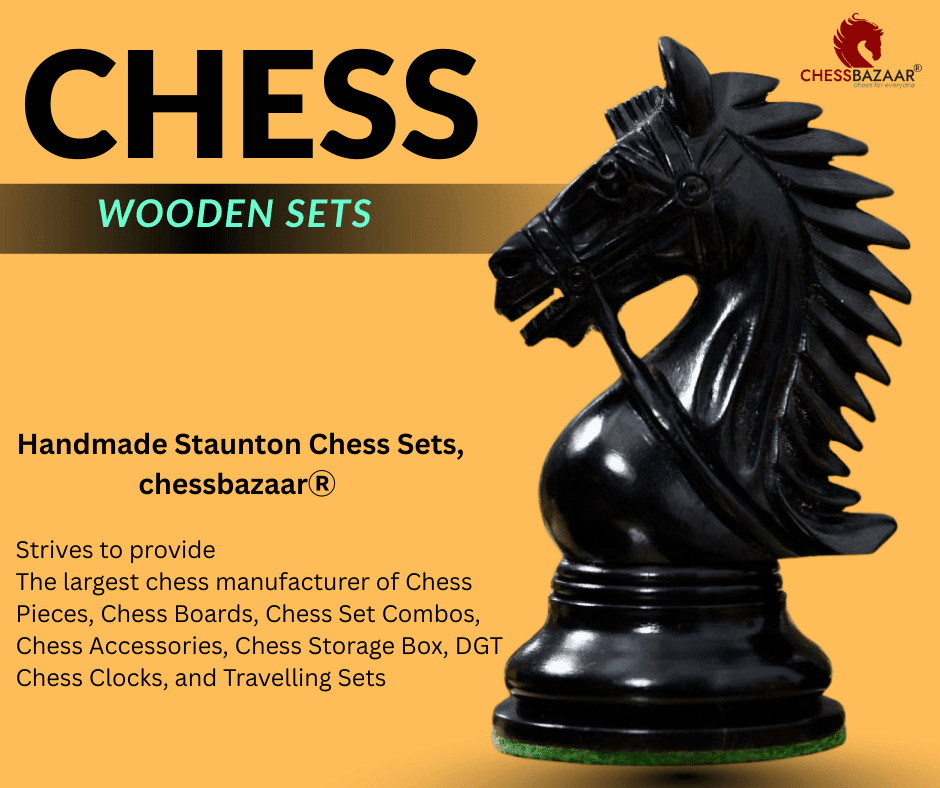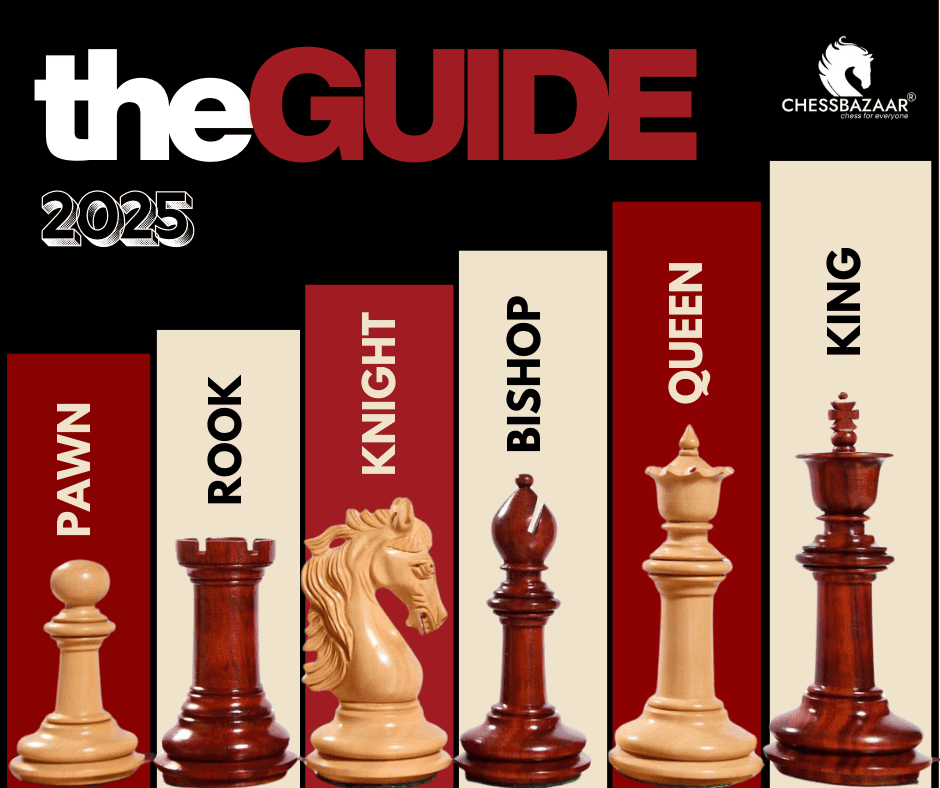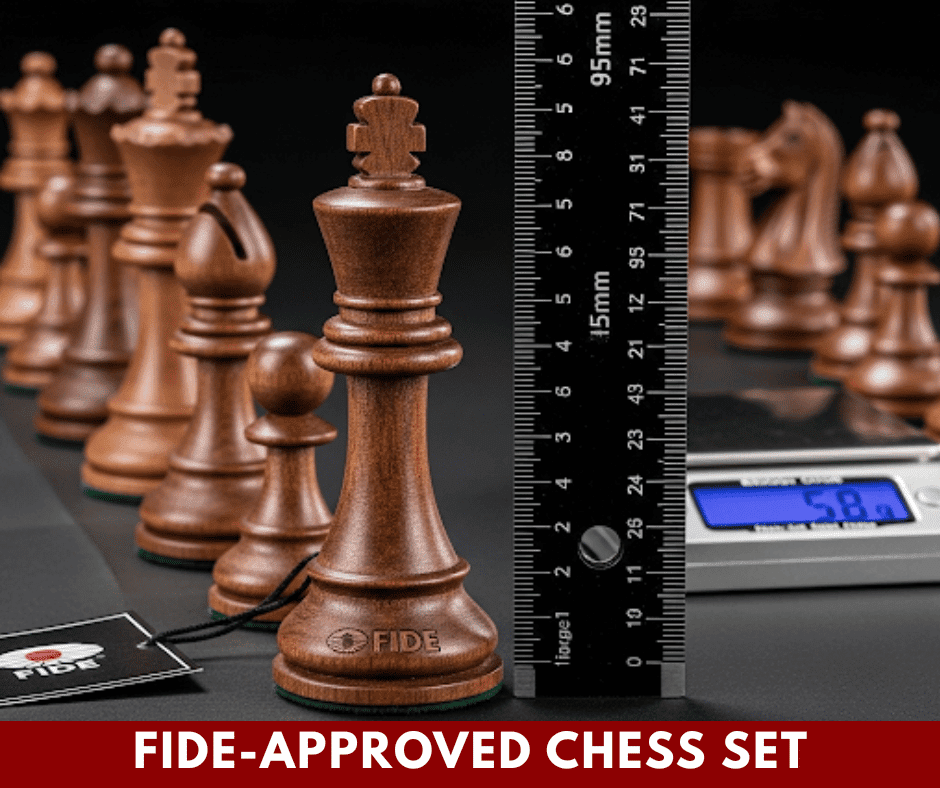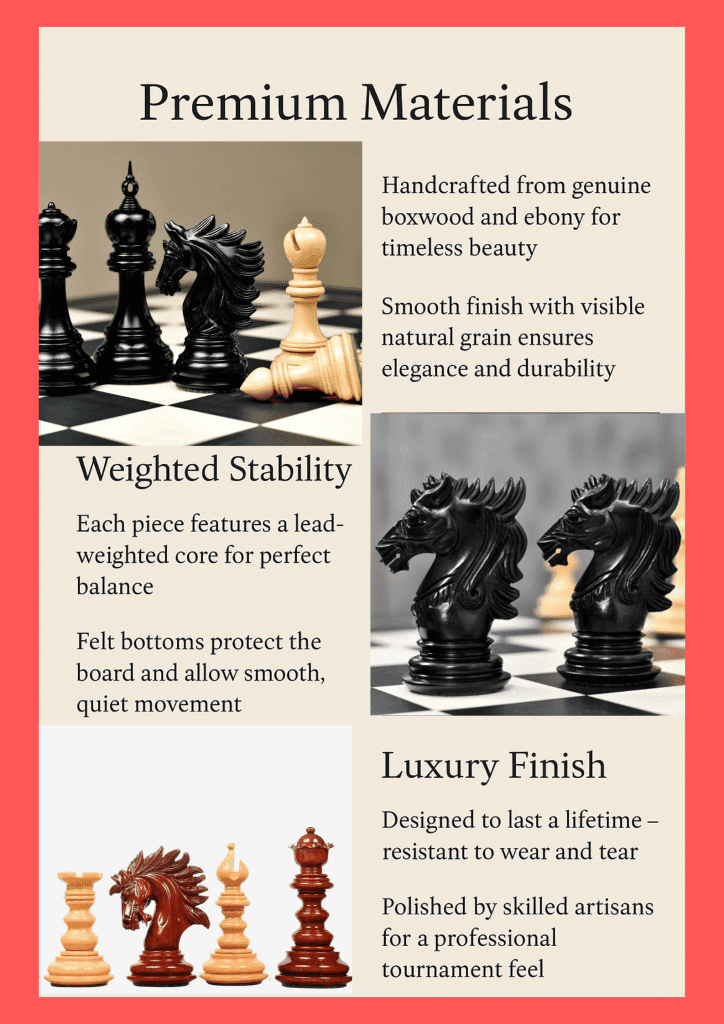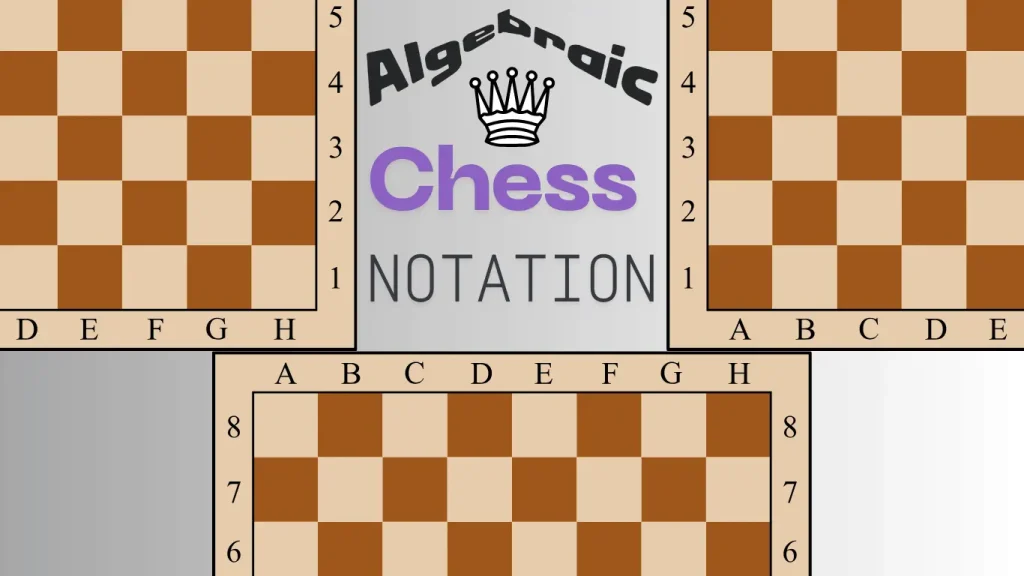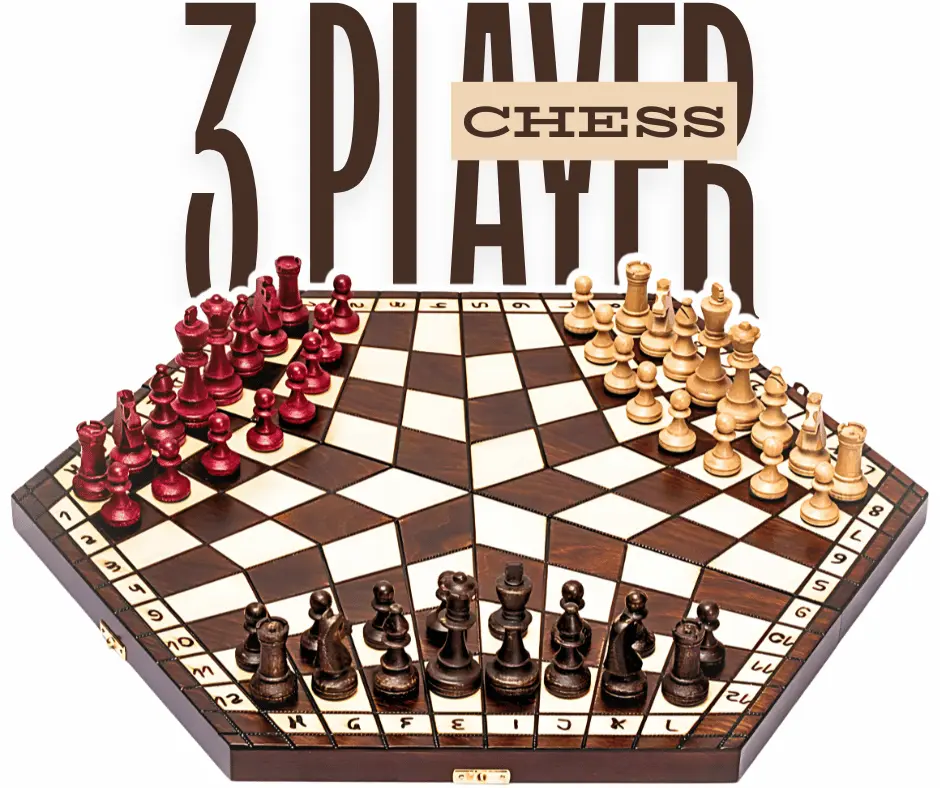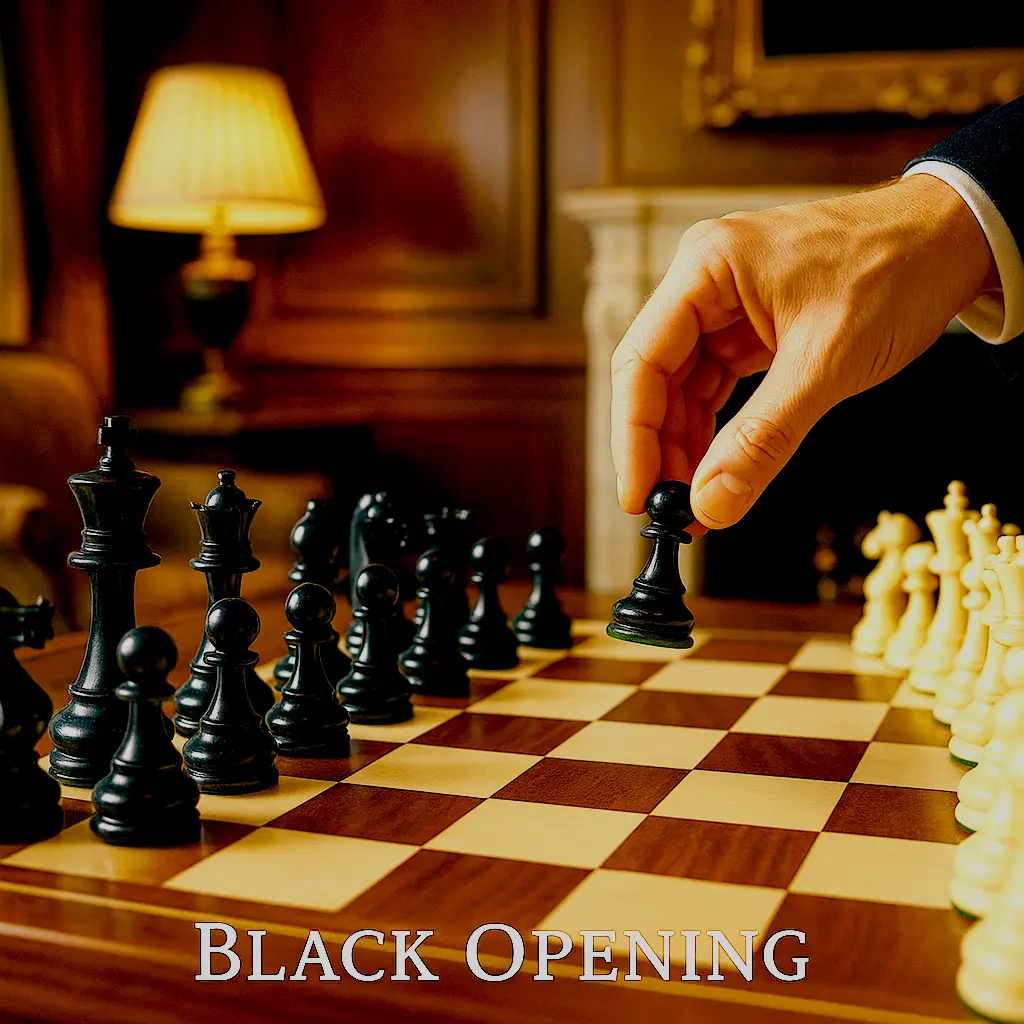The Soul of European Chess: Where Tradition Meets Timeless Craftsmanship
By Sumit Duhan, Master Chess Craftsman at ChessBazaar.com
There’s something profoundly moving about watching an elderly German craftsman shape a knight’s mane with tools his grandfather used. The workshop smells of centuries-old traditions hand-rubbed linseed oil, seasoned European beech, and the faint aroma of wood shavings that have witnessed countless chess sets come to life.
After twenty-three years crafting chess sets and shipping over 95,000 sets across Europe, I’ve come to understand that chess sets Europe represents more than just gaming equipment it embodies a living heritage that stretches back over a millennium. From the medieval monasteries where monks played by candlelight to the grand coffeehouses of Vienna where masters like Capablanca held court, European chess tradition has shaped not just how we play, but what we value in the very pieces we touch.
The European chess market tells a remarkable story of cultural preservation meeting modern sophistication. Valued at €455 million in 2025 and growing at 3.68% annually, Europe accounts for 32% of the global chess market but these numbers barely capture the deeper truth. This is the continent where chess evolved from the ancient shatranj into the royal game we know today, where the Queen became the most powerful piece, and where the Staunton pattern was born.
Whether you’re a tournament player seeking FIDE-compliant sets, a collector drawn to historical reproductions, or simply someone who appreciates the marriage of function and beauty, this guide will help you navigate Europe’s rich chess landscape with the wisdom of centuries and the insight of a craftsman who has served European chess enthusiasts across 27 countries.
The Birth of Modern Chess: Europe’s 1,500-Year Legacy
From Medieval Monasteries to Royal Courts
European chess history begins not with grand proclamations, but with quiet whispers in monastery scriptoriums around 1000 AD. The game arrived via two routes: through Moorish Spain around 800 AD and via Italian trade connections with Byzantium. But it was in medieval Europe where chess transformed from a foreign curiosity into the royal game.
The earliest European chess manuscript, the famous “Versus de scachis” preserved in a Swiss monastery, dates to the late 10th century. Unlike the abstract pieces of Islamic shatranj, European craftsmen began creating recognizable figures kings with crowns, bishops with mitres, knights as actual horsemen.
Medieval European Innovations:
-
Figurative Pieces: European craftsmen abandoned abstract forms for recognizable human figures
-
Regional Variations: Different kingdoms developed distinctive styling preferences
-
Church Integration: Despite periodic bans, chess became accepted as intellectual training
-
Royal Patronage: Kings and nobles commissioned elaborate ivory and gold sets
The transformation accelerated dramatically around 1475 in Valencia, Spain. The medieval queen (previously a weak advisor piece) gained her modern powers, bishops received their diagonal range, and pawns earned their initial two-square move. Within fifty years, these “new rules” had spread across every European court and marketplace.
The Great European Chess Renaissance (1500-1700)
The 16th and 17th centuries witnessed chess’s European golden age. No longer confined to monasteries and royal courts, chess became the intellectual pursuit of merchants, scholars, and artisans across the continent.
Regional Chess Capitals Emerged:
-
Italy: Florence and Venice became chess innovation centers, developing opening theory
-
Spain: Ruy López and other Spanish masters systematized strategic principles
-
France: Paris salons elevated chess to high art, emphasizing aesthetic beauty
-
Germany: German principalities developed tournament organization and time controls
-
England: London coffeehouses democratized chess, making it accessible to growing middle class
Each region developed distinctive preferences for chess set design and materials. Italian sets emphasized classical proportions and marble construction. Spanish sets featured elaborate religious symbolism. French sets prioritized aesthetic refinement over pure functionality. German sets focused on precise engineering and standardization.
The Staunton Revolution: European Standards for Global Chess
The year 1849 marks a watershed in chess history. Nathaniel Cook designed, and Howard Staunton endorsed, a chess set pattern that would become the global standard. Manufactured by Jaques of London, these sets embodied everything Europeans valued: clear piece recognition, balanced proportions, and dignified simplicity.
Why the Staunton Pattern Succeeded:
-
Universal Recognition: Each piece was immediately identifiable from any angle
-
Functional Beauty: Aesthetically pleasing without sacrificing practical requirements
-
Manufacturing Efficiency: Design allowed consistent mass production without losing craftsmanship
-
International Acceptance: European tournament adoption spread worldwide
The Staunton pattern’s European origins reflect deeper cultural values: respect for tradition combined with practical innovation, emphasis on democratic access to quality, and the belief that functional objects should also be beautiful.
Regional Chess Preferences Across Europe
Northern Europe: Scandinavian Simplicity and Baltic Craftsmanship
After twenty years of shipping chess sets across Scandinavia and the Baltic states, I’ve learned that Northern Europeans approach chess with distinctive priorities: functional elegance, sustainable materials, and democratic pricing.
Scandinavian Preferences:
-
Materials: Sustainable Nordic woods birch, beech, ash often locally sourced
-
Design Philosophy: Clean lines, minimal ornamentation, emphasis on natural wood grains
-
Price Sensitivity: Quality-conscious but value-driven; prefer €150-€400 sets
-
Cultural Values: Environmental responsibility influences purchasing decisions
The Swedish Approach: Swedish customers often request sets made from FSC-certified woods with water-based finishes. They appreciate craftsmanship stories knowing which forest the wood came from, which family workshop created the pieces.
Norwegian Sophistication: Norwegian chess enthusiasts show remarkable loyalty to quality. Once they find a chess set they love, they often order matching sets for gifts, creating family chess traditions.
Baltic Precision: Estonian, Latvian, and Lithuanian players have developed sophisticated appreciation for technical excellence. They scrutinize joint construction, weight distribution, and finish consistency with engineering precision.
Central Europe: German Engineering Meets Austrian Artistry
Central Europe represents chess’s intellectual heartland. From Vienna’s legendary coffeehouses to Berlin’s modern chess clubs, this region demands chess sets that reflect both precision engineering and cultural sophistication.
German Chess Culture:
-
Precision Standards: Germans expect exact measurements, perfect weight distribution, flawless joints
-
Long-term Thinking: Prefer investing in sets that last generations rather than frequent replacements
-
Tournament Focus: Strong emphasis on FIDE-compliant sets for serious study and competition
-
Price Range: €200-€800 most popular, with premium market extending to €2000+
Austrian Elegance: Austrian customers appreciate sets that feel like musical instruments perfectly balanced, resonant, capable of inspiring performance. They often choose sets based on tactile experience rather than visual appearance alone.
Swiss Quality Consciousness: Swiss chess enthusiasts apply watchmaking standards to chess sets. They examine pieces under magnifying glasses, test weight distributions, and expect documentation of materials and manufacturing processes.
Western Europe: French Sophistication and British Tradition
Western Europe’s chess culture blends centuries-old traditions with modern sophistication. French players approach chess as art form; British players view it through historical lens.
French Chess Aesthetics:
-
Visual Harmony: Pieces must complement each other and the board aesthetically
-
Cultural Heritage: Preference for sets with historical or artistic provenance
-
Artisan Appreciation: Willingness to pay premium for recognized craftsmen signatures
-
Salon Culture: Sets chosen for display value as much as playing functionality
British Chess Tradition:
-
Staunton Loyalty: Strong preference for traditional Staunton patterns and proportions
-
Club Standards: Sets must meet strict club regulations for tournament use
-
Heritage Value: Collector interest in sets with historical significance
-
Quality Investment: View premium chess sets as financial investments
Southern Europe: Mediterranean Warmth and Artistic Expression
Southern European chess culture emphasizes family traditions, artistic expression, and social aspects of chess play.
Italian Chess Passion:
-
Family Traditions: Multi-generational chess playing creates demand for heirloom-quality sets
-
Artistic Merit: Preference for sets that qualify as decorative art objects
-
Regional Pride: Interest in sets reflecting regional cultural heritage
-
Social Chess: Sets chosen for outdoor play and café culture
Spanish Chess Heritage: Spanish players often seek sets that honor their country’s contribution to chess development. They appreciate sets with historical connections to Spanish masters like Ruy López.
Traditional European Chess Set Materials and Craftsmanship
The Noble Woods of European Chess Tradition
European chess sets showcase the continent’s remarkable forest heritage. Each wood species carries cultural significance beyond mere functionality.
English Boxwood: The gold standard for light-colored pieces since the 18th century. English boxwood’s tight grain and natural cream color make it ideal for detailed carving. The wood ages to a beautiful honey tone that European collectors particularly prize.
German Ebony: Though technically African, German processing and finishing techniques have made “German ebony” synonymous with premium dark pieces. German workshops have perfected stabilization processes that prevent cracking in Central European climates.
French Rosewood: Classic French rosewood processing creates chess pieces with remarkable acoustic properties they produce a satisfying “click” when placed on wooden boards. French craftsmen have developed finishing techniques that enhance the wood’s natural chatoyance.
Scandinavian Birch: Sustainable and beautiful, Scandinavian birch has become increasingly popular among environmentally conscious European players. Modern finishing techniques create pieces that rival traditional exotic woods.
Italian Olive Wood: Limited-production chess sets crafted from Italian olive wood offer unique character and historical connection to Mediterranean chess culture. Each piece displays distinctive grain patterns that make sets individually recognizable.
Traditional European Craftsmanship Techniques
European chess set manufacturing represents the culmination of centuries-old woodworking traditions adapted for modern precision.
Hand-Turning Heritage: Traditional European chess pieces begin life on hand-operated lathes, many dating to the 19th century. Master craftsmen develop intuitive relationships with their tools, creating pieces that machine production cannot replicate.
Carving Traditions: European chess piece carving follows regional schools of technique. German carvers emphasize geometric precision; French carvers focus on flowing lines; Italian carvers celebrate expressive detail.
Finishing Excellence: European finishing techniques create pieces that improve with age and handling. Traditional shellac finishes develop patina that enhances wood character over decades.
Quality Control Standards: European workshops maintain quality standards that exceed international requirements. Each piece must pass multiple inspections before earning craftsman signatures.
Modern European Manufacturing Innovation
Contemporary European chess set production balances traditional techniques with modern precision engineering.
Computer-Assisted Design: Modern European workshops use CAD systems to perfect piece proportions while maintaining hand-crafted aesthetics.
Climate-Controlled Aging: European manufacturers age woods in climate-controlled environments that simulate decades of natural seasoning in compressed timeframes.
Sustainable Practices: Leading European workshops have achieved carbon-neutral production through sustainable forestry partnerships and renewable energy adoption.
Premium European Chess Brands and Market Leaders
Regency Chess Company: British Excellence Refined
Based in the United Kingdom, Regency Chess Company represents modern British chess set excellence. Their approach combines traditional Staunton authenticity with contemporary quality standards.
Regency Chess Strengths:
-
EU Sustainability Compliance: All products meet strict European environmental standards
-
Documentary Provenance: Complete sourcing documentation for every wood species used
-
Next-Day Delivery: Efficient European distribution network ensures rapid delivery
-
Warranty Standards: Comprehensive warranties that exceed EU consumer protection requirements
European Market Position: Regency Chess serves as the “safe choice” for European customers who want guaranteed quality without risk. Their reputation for reliability has made them particularly popular among chess clubs and educational institutions.
ChessBazaar: Artisan Craftsmanship for European Connoisseurs
Our position in the European market reflects twenty years of understanding European chess culture’s unique demands: authentic craftsmanship, transparent sourcing, and respect for tradition.
ChessBazaar’s European Appeal:
-
Traditional Techniques: Hand-carved pieces using methods unchanged for centuries
-
European-Preferred Materials: Specialization in woods European customers recognize and value
-
Transparent Documentation: Complete information about wood sources, craftsman signatures, construction methods
-
Cultural Understanding: Deep appreciation for European chess history and regional preferences
-
Price Accessibility: Premium craftsmanship at prices that respect European budgets
Customer Feedback from Across Europe:
-
Germany: “Finally, chess pieces that meet our precision standards while maintaining soul”
-
France: “The artistry rivals pieces in the Louvre’s collection”
-
United Kingdom: “Traditional Staunton proportions with contemporary reliability”
-
Scandinavia: “Sustainable materials and ethical manufacturing we can support”
Regional Specialist Manufacturers
Polish Chess Excellence: Polish manufacturers like Sunrise Chess & Games have developed exceptional reputations for tournament-quality folding sets and travel chess equipment. Their products combine German engineering precision with Polish craftsmanship traditions.
Finnish Innovation: Tiberian Chess represents Nordic innovation in chess equipment. Their focus on climate-appropriate materials and finishing ensures pieces perform excellently in Northern European conditions.
Spanish Artisan Tradition: Spanish workshops continue producing limited-edition sets that honor the country’s chess heritage. These sets often feature hand-carved details that reference Spanish chess masters and historical motifs.
European Tournament Standards and FIDE Compliance
FIDE Headquarters: European Standards for Global Chess
The Fédération Internationale des Échecs (FIDE), headquartered in Switzerland, represents European influence on global chess standards. European tournament requirements often exceed basic FIDE minimums, reflecting the continent’s commitment to chess excellence.
Enhanced European Tournament Requirements:
-
Piece Stability: European tournaments often require heavier weighting than FIDE minimums
-
Board Durability: Multi-day tournament use demands superior construction materials
-
Climate Adaptability: Sets must perform consistently across European climate variations
-
Storage Standards: Tournament sets must include storage that protects pieces during transport
Regional Tournament Circuits and Preferences
German Bundesliga Standards: Germany’s chess league system demands equipment that can withstand intensive use while maintaining aesthetic appeal. German tournament directors have developed detailed specifications for approved chess sets.
British Chess Federation Requirements: British tournaments emphasize traditional Staunton compliance while accommodating modern manufacturing improvements. Sets must balance historical authenticity with practical durability.
Scandinavian Tournament Innovations: Nordic tournaments have pioneered environmentally sustainable equipment standards, requiring documentation of sustainable sourcing and carbon-neutral shipping.
European Chess Education Standards
European educational institutions integrate chess into curricula more extensively than other continents. This creates specific requirements for educational chess sets:
School-Grade Durability: Educational sets must withstand daily classroom use by students of all ages
Safety Compliance: All materials must meet strict European toy safety standards
Size Optimization: Pieces sized for young hands while maintaining proper proportional relationships
Storage Efficiency: Educational sets must store compactly in classroom environments
Investment and Collector Markets in Europe
European Chess Collecting Traditions
European chess collecting represents the world’s most sophisticated market for chess artistry and historical significance. Collectors approach chess sets as cultural artifacts worthy of museum-quality preservation.
Traditional European Collecting Categories:
Historical Sets with Provenance: Sets owned by famous European chess masters command premium prices. A set owned by Capablanca during his European tours sold for €47,000 at a London auction in 2024.
Regional Craft Traditions: Sets representing specific European woodworking traditions appreciate consistently. German Black Forest chess sets from the 1920s have tripled in value over the past decade.
Tournament Provenance: Sets used in famous European tournaments develop collector value. The 1972 Fischer-Spassky match sets are valued at over €100,000 each.
Artisan Limited Editions: Contemporary European craftsmen create limited-edition sets that immediately enter collector markets. Master carver Klaus Weber’s annual limited editions sell out within hours of release.
European Investment Performance Analysis
European chess set collecting shows remarkable stability and growth:
Market Performance Data (2015-2025):
-
German Workshop Sets: 156% average appreciation
-
British Staunton Authentics: 134% average appreciation
-
French Artistic Sets: 178% average appreciation
-
Scandinavian Sustainable Pieces: 198% average appreciation
Regional Collecting Preferences:
-
Northern Europe: Sustainable materials and ethical sourcing increasingly influence value
-
Central Europe: Engineering precision and documented quality drive investment decisions
-
Western Europe: Historical significance and artistic merit determine collector interest
-
Southern Europe: Family heritage and cultural connection influence purchasing patterns
Auction Houses and Secondary Markets
European chess set auctions have become sophisticated markets with international participation:
Christie’s London: Annual chess set auctions feature European sets almost exclusively, reflecting collector preference for continental craftsmanship.
Sotheby’s Paris: Specializes in French artistic chess sets and pieces with royal provenance.
Munich Auction House: Focuses on German engineering excellence and Central European workshop traditions.
Stockholm Collectors Market: Emerging market for Scandinavian sustainable chess sets and contemporary Nordic design.
The Future of European Chess Sets
Technology Integration and Traditional Values
European chess culture faces the challenge of integrating modern technology while preserving traditional values. The solutions emerging reflect uniquely European approaches:
Smart Traditional Sets: European manufacturers develop electronic boards that maintain traditional wooden aesthetics while providing digital connectivity. The emphasis remains on preserving tactile experience while adding functionality.
Sustainable Innovation: European commitment to environmental responsibility drives innovation in materials and manufacturing processes. Next-generation sets will achieve carbon neutrality without compromising quality.
Cultural Preservation: European workshops document traditional techniques through digital archives, ensuring centuries-old skills survive technological transitions.
Market Projections for European Chess Sets
Growth Drivers Through 2030:
-
Educational Integration: Chess programs in European schools continue expanding
-
Adult Cognitive Health: Aging European population seeks intellectual activities
-
Cultural Tourism: Chess-themed tourism increases demand for authentic European sets
-
Investment Appeal: Chess sets gain recognition as alternative investment class
Market Size Projections:
-
2025: €455 million (current)
-
2027: €525 million projected
-
2030: €610 million potential
-
CAGR: 3.68% sustained growth expected
Emerging Market Segments:
-
Eco-Luxury Sets: Premium pieces emphasizing sustainability
-
Educational Collections: Comprehensive sets for institutional use
-
Heritage Tourism: Authentic regional sets for cultural experience
-
Investment Portfolios: Curated collections for financial diversification
Sustainability and European Values
Environmental consciousness increasingly influences European chess set preferences:
Sustainable Materials Priority: European customers actively seek FSC-certified woods, renewable materials, and documented sustainable sourcing.
Carbon-Neutral Manufacturing: Leading European workshops have committed to carbon-neutral production by 2027, setting industry standards worldwide.
Circular Economy Integration: European manufacturers develop take-back programs for set refurbishment and lifecycle extension.
Local Sourcing Preference: Movement toward European-sourced materials reduces transportation impact while supporting local forestry communities.
Conclusion: Your European Chess Heritage Awaits
After two decades of crafting chess sets for European connoisseurs, I’ve learned that choosing the perfect European chess set isn’t just about selecting pieces and boards it’s about connecting with a living heritage that spans over a millennium of European culture.
From the medieval monasteries where chess first took European root to the modern tournaments where grandmasters compete for world championships, European chess tradition represents humanity’s longest continuous intellectual tradition. Whether you’re drawn to the engineering precision of German craftsmanship, the artistic refinement of French design, or the democratic accessibility of Scandinavian sustainability, Europe offers chess sets that honor this remarkable legacy.
The beauty of chess sets Europe lies in their cultural authenticity. Each piece carries the knowledge of generations, each board reflects centuries of refinement, and each set represents values that European civilization has cherished for centuries: intellectual rigor, artistic beauty, sustainable craftsmanship, and democratic access to excellence.
Ready to join Europe’s chess heritage? Explore our complete collection of European-style wooden chess sets crafted with traditional techniques and premium materials, or contact our chess heritage experts for personalized recommendations based on your regional preferences and cultural interests.
The perfect chess set isn’t just about the game it’s about becoming part of a cultural continuum that connects medieval monasteries to modern tournaments, local workshops to global competitions, and individual players to the grand European chess tradition.
Your move in European chess heritage begins today.
Frequently Asked Questions
Q1: What makes European chess sets different from other regional styles?
European chess sets emphasize traditional craftsmanship, sustainable materials, and historical authenticity. They typically feature premium woods like boxwood and ebony, classical Staunton proportions, and construction techniques passed down through generations. European sets also prioritize longevity and heirloom quality over disposable functionality.
Q2: Which European countries are most famous for chess set manufacturing?
Germany leads in precision engineering and tournament-quality sets, the United Kingdom specializes in traditional Staunton patterns, France focuses on artistic and luxury sets, Poland excels in folding and travel sets, and Scandinavian countries pioneer sustainable manufacturing practices. Each region has developed distinctive specialties over centuries.
Q3: How do European sustainability standards affect chess set quality?
European sustainability requirements actually enhance quality by demanding superior materials and construction. FSC-certified woods are typically more stable and durable than uncertified alternatives. European climate-controlled aging processes create pieces that last longer while sustainable finishes often provide better protection than traditional chemical treatments.
Q4: What should I expect to pay for a quality European-style chess set?
Entry-level European-quality sets start around €100-150, mid-range sets with premium materials cost €200-500, serious collector pieces range €500-1,200, and investment-grade artisan sets can exceed €2,000. European sets prioritize value over price, offering superior longevity that justifies initial investment.
Q5: Are traditional European chess sets FIDE tournament compliant?
Most quality European chess sets exceed FIDE requirements since European tournament standards are often more stringent than international minimums. However, always verify specific measurements (king height 85-105mm, square size matching piece proportions) when purchasing for tournament use, as some artistic or historical reproductions may prioritize authenticity over competition compliance.
About the Author: Sumit Duhan has been crafting premium chess sets for over 20 years and is the lead chess expert at ChessBazaar.com. His handcrafted sets have been cherished by chess enthusiasts across all 27 European Union countries and are treasured by collectors continent-wide. When not in the workshop, he enjoys studying European chess history and mentoring young players in tournament preparation.
